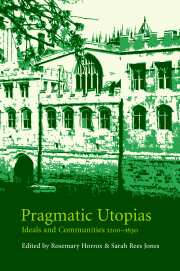Book contents
- Frontmatter
- Contents
- Preface
- List of abbreviations
- Richard Barrie Dobson: an appreciation
- 1 ‘If heaven be on this earth, it is in cloister or in school’: the monastic ideal in later medieval English literature
- 2 The ‘Chariot of Aminadab’ and the Yorkshire priory of Swine
- 3 Godliness and good learning: ideals and imagination in medieval university and college foundations
- 4 Hugh of Balsham, bishop of Ely 1256/7–1286
- 5 A cruel necessity? Christ's and St John's, two Cambridge refoundations
- 6 Coventry's ‘Lollard’ programme of 1492 and the making of Utopia
- 7 Thomas More's Utopia and medieval London
- 8 Social exclusivity or justice for all? Access to justice in fourteenth-century England
- 9 Idealising criminality: Robin Hood in the fifteenth century
- 10 Fat Christian and Old Peter: ideals and compromises among the medieval Waldensians
- 11 Imageless devotion: what kind of an ideal?
- 12 An English anchorite: the making, unmaking and remaking of Christine Carpenter
- 13 Victorian values in fifteenth-century England: the Ewelme almshouse statutes
- 14 Puritanism and the poor
- 15 Realising a utopian dream: the transformation of the clergy in the diocese of York, 1500–1630
- Bibliography of Barrie Dobson's published works
- Index
5 - A cruel necessity? Christ's and St John's, two Cambridge refoundations
Published online by Cambridge University Press: 01 July 2009
- Frontmatter
- Contents
- Preface
- List of abbreviations
- Richard Barrie Dobson: an appreciation
- 1 ‘If heaven be on this earth, it is in cloister or in school’: the monastic ideal in later medieval English literature
- 2 The ‘Chariot of Aminadab’ and the Yorkshire priory of Swine
- 3 Godliness and good learning: ideals and imagination in medieval university and college foundations
- 4 Hugh of Balsham, bishop of Ely 1256/7–1286
- 5 A cruel necessity? Christ's and St John's, two Cambridge refoundations
- 6 Coventry's ‘Lollard’ programme of 1492 and the making of Utopia
- 7 Thomas More's Utopia and medieval London
- 8 Social exclusivity or justice for all? Access to justice in fourteenth-century England
- 9 Idealising criminality: Robin Hood in the fifteenth century
- 10 Fat Christian and Old Peter: ideals and compromises among the medieval Waldensians
- 11 Imageless devotion: what kind of an ideal?
- 12 An English anchorite: the making, unmaking and remaking of Christine Carpenter
- 13 Victorian values in fifteenth-century England: the Ewelme almshouse statutes
- 14 Puritanism and the poor
- 15 Realising a utopian dream: the transformation of the clergy in the diocese of York, 1500–1630
- Bibliography of Barrie Dobson's published works
- Index
Summary
On 8 April 1511, John Fotehede, Master of Michaelhouse, wrote from Cambridge to John Fisher, bishop of Rochester, formerly spiritual advisor to Lady Margaret Beaufort and now one of her executors, urging faster progress on the buildings of her foundation of St John's College. Fotehede himself had served as her controller of finances in 1504–6, and had presented her statutes to the fellows of Christ's College, her earlier foundation, in the latter year. Both colleges were endowed and built with the resources of the countess's household and estates, and both had transfigured and replaced previous smaller foundations on the same sites. The later educational prestige of the colleges has dwarfed the institutions which preceded them; but for contemporaries there were priorities other than education which weighed equally or even more strongly.
Fotehede's letter mentioned the importance of local opinion in the furtherance of the project; but it was not, according to the writer, an opinion concerned with education. It focussed rather on elements in the old foundation, the thirteenth-century hospital of St John the Evangelist under the patronage of the bishops of Ely, which remained precious to local people. Some headway had been made in negotiations with adjoining King's Hall to secure the southern boundary of the new college, but progress was now held up by the reluctance of the last members of the hospital to surrender a bond in their possession, and the intervention of Dr William Robinson, the bishop of Ely's commissary, was called for.
- Type
- Chapter
- Information
- Pragmatic UtopiasIdeals and Communities, 1200–1630, pp. 84 - 96Publisher: Cambridge University PressPrint publication year: 2001



